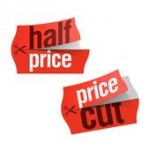 No doubt you have heard of the seven cardinal sins of the Christian religion – wrath, greed, sloth, pride, lust, envy and gluttony? But did you know that there are also seven lethal sins of selling? And they’re deadly because they’re toxic to your business and your bank account.
No doubt you have heard of the seven cardinal sins of the Christian religion – wrath, greed, sloth, pride, lust, envy and gluttony? But did you know that there are also seven lethal sins of selling? And they’re deadly because they’re toxic to your business and your bank account.
Unfortunately, if you commit even one of them, you’ll find that your sales leads will shrivel up and die right before your eyes…
If you want to capture the attention of more prospects and increase sales, you need to stop committing all of these deadly sins.
Are you guilty of:
- A lame approach or introduction?
- Wasting your prospect’s time with stuff that is important to you but not to them?
- Failing to identify and understand your customer’s pain?
- Forgetting to give your audience a clear message why they should choose you?
- Selling products, features or benefits instead of solutions to their pain?
- Neglecting to prove beyond a shadow of a doubt that you can cure their pain?
- Making it easy for them to talk themselves of out of the sale? or
- Giving too many options (or not asking for the sale)?
Thankfully, there is a cure to help you increase sales and it is a whole lot simpler than you might imagine. Which is lucky for you – because right now, you are killing leads and losing sales with each sin that you commit.
Everyone knows that a solid, consistent stream of prospects and sales are vital to the health and success of your business. And right now, you are spending a lot of money each month on activities and communications where 99% of your audience chooses not to buy from you. It’s a lot of money to waste on sales presentations, calls and emails that aren’t working, isn’t it?
Now depending on which deadly sins you are committing (one, two or all seven of them), many of your prospects have gone to one of your competitors to get their pain cured. I would like to show you exactly where you went wrong and what you need to do to fix your message and increase sales. I want to show you how to turn your message into one that your audience is dying to say “YES” to.
- Keep the Lights on – Often presenters switch off the lights in a room so that the slides can be read more easily. Besides encouraging the decision making part of your prospect’s brain to fall asleep, this fatal move also diverts attention to the screen – when you need to do to increase sales is have your audience focus their attention on the conversation you are having with them.
- Capture attention upfront – In order to stand out and be remembered, you need to open with a question, story, myth-busting statement, or picture that is relevant to your audience. The best way to increase sales is to show them you understand (and can solve) their #1 source of pain.
- Stop wasting time on you – Never waste your time telling potential customers about you. 100% of your message should focus on your prospect or customer, and how your solution will cure her pain, keep her safe, or make her life better. If you message is relevant and your customer is engaged, it will increase sales.
- A picture is worth 1000 words – Your brain is hardwired to process visual cues and act before you have time to think things through carefully. If you want to connect with your audience and increase sales, you need to present fewer words, graphs and statistics and start showing them in pictures how their life will be better with your solution.
- Simplify your message – Most slides have far too many words on them to be persuasive. Less is more – if your audience is too busy reading, they cannot possibly engage with you and your key message. The brain can only process and memorize 3 or 4 key points at a time. If your message is more complex than that, it simply will not be remembered.
- Use stories to communicate your key points – messages that cause your customers to reconnect with or rediscover strong emotions from their past and associate those with your solution, are 10x more likely to trigger the part of the brain that decides.
- Crank up the contrast – In order to trigger a decision quickly and increase sales, you must stand out. Your customer needs to feel the difference between your solution, your competitor’s solution, doing it themselves, or doing nothing.
By mastering these 7 steps, you are now ready to go back to the beginning, rework what you say and how you say it in order to influence a speedy decision in your favour and increase sales. These 7 steps will help you to STOP falling prey to the 7 deadly sins of selling that we talked about earlier. They are going to help you increase the effectiveness of your message and also reduce the amount of time and money that you need to spend chasing leads and sales.
When you make it easier for your audience to see and grasp your message, he/she is more likely to decide and will on some level appreciate the fact that you have not wasted his time and energy with stuff that wasn’t important to him.
13 Jun 2013
Why Do You Need a Business Coach?
 Do you aspire to be a great leader and grow your business profitably this year? Then it’s time to find the right business coach who can inspire and empower you to step up and reach your goals.
Do you aspire to be a great leader and grow your business profitably this year? Then it’s time to find the right business coach who can inspire and empower you to step up and reach your goals.
Almost every business is under pressure right now to attract more leads and close more sales in this tough economic environment where global competition is increasing every day for your potential audience. It is hard enough to keep up with the changes in your industry and the barrage of ads that target your potential customers – not to mention the innovation in technology, increasing complexity of running your business and complying with the tax legislation, HR issues, operational challenges and business planning. Having a Business Coach isn’t a luxury in this day and age, it is a necessity that you need in order to survive and thrive.
By far, one of the biggest assets that you will gain as a result of working with a business coach is accountability. Remember, it’s difficult to get a truly objective perspective or opinion from yourself, your spouse or your team members, but your business coach is there to be your “unreasonable friend” – to tell you the truth, challenge your assumptions, push your boundaries and motivate you to take action (especially when you are procrastinating).
A Business Coach or mentor will teach you “how to fish” rather than simply putting a fish in your hands when you need it. With years of successful experience (running their own business and helping hundreds of other entrepreneurs just like you), your business coach will help you develop and achieve your goals, put a solid business plan in place, execute effective strategies that will grow your bottom line, track and measure your progress and highlight blind spots or opportunities that you have overlooked.
You may be able to scrape by without the help of a business coach, but it’s almost impossible to consistently grow your business profitably without the training, guidance and focus you will achieve by working with a good business coach.
Find out more today by contacting us to speak to a business coach that can help you breakthrough your perceived limitations, make better decisions, step up as a leader and achieve your goals.
And remember, most importantly a business coach will:
- help you focus and eliminate all tasks that are taking up resources but adding value
- challenge assumptions and perceived limitations about your business and industry
- motivate you to ask better questions and make better decisions
- highlight opportunities or pitfalls that may not be obvious to you
- give you tips and proven strategies based on years of experience across many different industries
- be a valuable sounding board and provide a balanced, objective perspective
- help you develop and execute plans that grow the bottom line and cash flow safely & predictably
- track and measure your financial progress in a way that is meaningful to you
- assist with an exit strategy
- be your unreasonable friend with a wealth of experience across multiple disciplines – marketing, sales, training, systems, leadership, finance, legal issues and technology.
 All of the leading experts recommend that you spend 75% of your budget to retaining existing customers (and re-engage them). Yet surprisingly, most companies do the exact opposite. Even large corporations like Coles, Woolworths, Max Factor and Target (not just the little SMEs) make the mistake of spending too much chasing new customers (or ones that have left) and often ignore their existing ones.
All of the leading experts recommend that you spend 75% of your budget to retaining existing customers (and re-engage them). Yet surprisingly, most companies do the exact opposite. Even large corporations like Coles, Woolworths, Max Factor and Target (not just the little SMEs) make the mistake of spending too much chasing new customers (or ones that have left) and often ignore their existing ones.
Several years ago I held a senior commercial role at one of the largest retail businesses in the country and I can confirm that they spent <20% to retain existing customers. They, like 95% of businesses out there, spend the bulk of their budget on chasing new customers or attempting to re-engage those that have left and gone to the competition.
And therein lies the biggest mistake you can make as a business owner…
Every dollar spent on direct marketing to retain existing customers is actually worth 50x the equivalent amount spent chasing new customers. With above the line advertising, it is very hard to capture the attention of new customers, embed your message in their mind and compel them to act. It is much easier (and cheaper) to reinforce your message with an existing customer and encourage repeat visits.
So, if everyone knows it is easier and cheaper, why are most businesses NOT focusing the majority of their attention and budget on their existing customer base? The answer to that question is unclear. But what is clear is that there are 4 Simple Strategies that you can use today to boost sales and retain existing customers.
1. Spend 75% of Your Budget on Existing Customers – The bulk of sales and marketing efforts should be focused on direct communications and NOT on social media, newspapers, PR, magazines or pay-per-click advertising. For those of you who are established and have been in business for a few years, this is going to free up a lot of time that has been wasted on chasing new customers.
2. Do Your Homework to Maximize Return on Investment (ROI) – I recommend that you take the time today to analyse your existing customer data:
– What are they buying?
– What could you introduce them to which would increase gross profit margin?
– How can you drive frequency (visits)?
3. Frequency Lifts Sales by 75% More Than Upselling – It is much more effective and profitable, to focus on getting customers to return to your website or business, as opposed to trying to sell them one more thing while they are there.
4. Focus on Customers Within a 10km radius – Customers who have moved outside a 10km radius of your business can be particularly tricky to re-engage. In research conducted at one of the largest retailers in the country, we discovered that 82% of the revenues were attributable to customers that lived within a 10km radius. And in my experience working with hundreds of small-midsized businesses, this statistic still holds true. If your customer has moved outside of this radius, it does not make sense to waste any of your budget trying to reactivate them.
Even though it’s important to appeal to and attract new customers, it’s absolutely crucial to your business’s survival that you retain and nurture the customers that have supported and shopped with you to date. Everyone knows that is cheaper and easier to garner incremental business from existing customers but what separates the truly successful entrepreneur from the pack is the ability to put this knowledge into practice by allocating a large portion of your budget and focus to existing customers.
 What would it be worth to you if never had to worry again about competing based on price alone?
What would it be worth to you if never had to worry again about competing based on price alone?
If your customers keep asking you for a better price, I am going to show you how to get the price that you deserve and close more sales.
We now know there are 3 distinct parts of the brain and each one of them has a different function. However, only 1 of them is responsible for decision making and it fires up around 8 seconds before you are consciously aware that you have even made a decision. The research and information I am about to share with you hasn’t come from psychology, the personal development industry or even a marketing agency – these findings were made by neuroscientists studying brain wave activity with fMRI, EEG and retinal tracking devices. They were looking to find out which part of your brain lights up when it is presented with different stimuli and the findings have been documented and published in respected publications like the Wall Street Journal and the Harvard Medical Journal.
The biggest part of the brain is the neo cortex. We are the only species on the planet that has developed this part of the brain. It is the last thing that forms in the womb and it lights up when we listen to music, look at colours, speak, read and process numbers. If you ever hear people talking about right vs. left brain thinking, they are talking about the neo cortex. In a nutshell – IT THINKS.
Similarly, when your customer says “I need to think about it” or “is this the best price I can get?” this part of the brain is firing up and looking for data. This uses up tons of your brain energy and prolongs the decision making process. If you want to drag out the process of getting your customer to decide or compete on price, you want to make sure that your customer has to us this part of his brain. Make sure you give your customer lots of BIG words, numbers, graphs, lists of features and benefits, talk about your competitors and how you stack up next to them – and your customer will NOT decide BUT he will do a whole lot of thinking and take up more of your valuable time and energy in the process.
Let’s move on to the middle or mammalian brain – this is the part of the brain that we share will every warm blooded creature on the planet. This is where you process emotions and feel. But this is not where you make decisions.
At the top of your spinal cord, there is a collection of neurons – which are commonly referred to as the old or reptilian brain. This is the first part of your brain that is formed in the womb and it is the part that keeps you alive – all bodily functions that take place below the level of consciousness, are controlled by this part of your brain.
It is your fight or flight brain – and its sole responsibility is to ensure your safety and survival. It houses the amgydala – which is the chemical factory in your brain that regulates all bodily functions. And it is the part of the brain that lights up when you DECIDE.
It lights up even before you have conscious awareness that you have made a decision. Now, while it is very true that this is the most primitive part of your brain, the good news is that it is very predictable. By understanding how this part of your brain works, you will never again bore and overwhelm your customers AND you will never again be lured into the trap of competing based on price.
How will you do this? By understanding how this part of your customer’s brain works, you can help him to use the least amount of mental energy in processing your message which means that he will make quicker decisions. It is important to remember that unlike the neo-cortex up here (the thinking part of your brain), this part right of your brain is automatic – it does not think, it only DECIDES and ACTS. It is always at work scanning your environment looking for information of value to your survival.
So you might be wondering how does this apply to the price that you charge for your product/service?
Just for a moment, I want you to imagine that you are in the business of selling pizzas. Now, it doesn’t matter whether your business is called Pizza Hut, Dominos, Boston Pizza or Pizza World… you are basically selling an undifferentiated product and the market that you find yourself in looks price conscious, doesn’t it? The reason for that is simple – the consumer finds it hard to distinguish between your pizza and the next guy.
Now if you happen to BE the owners of a Chicago Deep dish pizza shop you might argue that your pizza is better because your crust is thicker and you provide more toppings and value. But in the eyes of the consumer, your pizza is still not really worth much more than the next guy’s pizza. You might be charging $20 and your competitor is charging $18.50. Why is that?
It’s because even though you think there is a difference, in the eyes of your customer, there isn’t. 95% of what you and the next guy offer are essentially the exact same thing. And as long as you keep operating in that zone with a marketing message that doesn’t stand out and stake a claim, you will continue to compete on prize because your customer is up in his neo-cortex trying to figure out which pizza is the best one to order.
So knowing this, what could you do differently? Well one company in 1973 identified a way to stand out and grab market share. It didn’t claim to have the best, the thickest or even the cheapest pizza, it just made you a promise that if you ordered from them, you would get it in 30 minutes or your pizza was free. It was the most successful campaign in the history of the industry – for good reason.
Think about it, when you order a pizza, what is the one question that you have in the back of your mind? I wonder when the pizza will get here?
Dominos answered that question for you. They stopped making you need to think about it and they triggered the part of your brain that decides and dials.
This is the power of Sales Seduction – understanding why your customer says YES and knowing what to say in order to close more sales. Can you see now how knowing this information can help you accelerate your sales process, close more sales, trigger decisions and allow you to charge a fair price for your product/service?
Great – so your homework today is to go back through one of your sales or marketing messages and identify all the ways that you are boring or overwhelming your prospects. The key to NOT competing on price ever again, lies in doing your homework to help you close more sales.
 If you’re in business, one of the most important questions that you must be asking yourself is “what is the best way to grow your business?” How can you take what you have, expand on it but keep your costs as low as possible?
If you’re in business, one of the most important questions that you must be asking yourself is “what is the best way to grow your business?” How can you take what you have, expand on it but keep your costs as low as possible?
Fortunately, history has given us plenty of good examples of how NOT to do this. Perhaps the best of these happened in 2001 – when thousands of companies went under in the dot com bubble.
But how did so many go so far wrong?
In those days, start-ups (with little or no income) and existing companies (with dreams of expanding their business online) were renting the biggest and best offices. They were signing huge print advertising contracts, paying ridiculous sums for banner ads and taking enormous salaries.
When sales were lower than expected and the cash to keep paying all those expenses dried up, these businesses had no way of easily adjusting their monthly expenditures because they were primarily FIXED, not variable. Their only option was to declare themselves bankrupt and close down.
Compare this situation with Amazon.com which started in a suburban garage with old doors on sawhorses for desks. By keeping fixed costs down, they were able to stay in business long enough to start generating a profit. They are now a huge company (with real offices) making huge profits.
So how does all of this apply to your company?
No matter how big your current business is, the aim is to grow your business while keeping your fixed costs as low as possible as a percentage of sales. And there are many practical ways to do this.
Begin by creating a simple excel spreadsheet of your current revenue and expenses each month. Ensure that you have correctly separated the fixed and variable costs of doing business. Roughly speaking, the breakdown should look something like this:
Revenue
– Cost of Sales (includes cost of goods and wages for subcontractors)
= Gross Profit
– Fixed costs (includes rent, wages, marketing, telephone and utilities etc.)
= Net Profit
Based on your current financial results, set your monthly revenue targets for the next 12 months and estimate the cost of goods sold. For example, if you currently generate $20,000/month in sales with a 60% gross profit margin, you might like to grow your business by 25%? Therefore, you would use a projected sales target of $25,000 each month with Cost of goods sold at around $10,000 as a starting point. This would leave you with a gross profit each month of $15,000. If your sales fluctuate each month due to seasonal variations, manually adjust your forecast to reflect these ups and downs so that you will have a more realistic picture of your financial performance.
Now here is where most business owners will go wrong…
Most business owners will make the mistake of assuming that fixed costs are fixed – the owner will just blindly start to place the existing amounts for rent, marketing, wages, telephone etc. into the financial projections. Fixed costs are referred to as fixed because they are fixed at a point in time. This does not mean however, that they are fixed forever and cannot be altered. In fact, when you are preparing a business plan and financial projections to grow your business, you should consider almost every aspect of your business as “up for debate and re-adjustment”.
That is one reason why you need a decent business plans – you can use it to re-evaluate and plan for the future so that you can improve and grow your business. Without a concrete plan, in all likelihood, you will continue to get the exact same results that you got last year.
Where you will get the most value in this exercise is by going back over each cost (fixed or variable) to identify opportunities to improve your gross and net profit margins. Cutting costs may be possible and advisable in some areas of your business. However, cutting costs [in isolation] is not usually an effective strategy to grow a business. In order to grow and improve your bottom line, you will need to ask yourself the question – “how can I grow my business without expanding costs”?
Here are some effective ways to do just that:
1. Think of ways to partner with others to expand your reach and sales without actually having to open another location or hire more full time employees. You may already have underutilized capacity to increase your sales right now.
2. Introduce products or services that complement the ones that you currently have and contribute more to the bottom line of your business.
3. Re-negotiate the terms or prices you have with your suppliers to increase your gross profit margin.
4. Selling online is a very cost effective way to increase your reach without increasing fixed costs.
5. If you manufacture goods, you could identify ways to increase production simply by tidying up, rearranging the layout of machines and planning more cleverly (to reduce work in progress and downtime). Often mistakes and rework can be costly to your business and surprisingly, they can be prevented by taking time during the business planning process to brainstorm solutions. Making better use of time is another fantastic way to increase production with minimal impact on fixed costs.
Surprisingly, 95% of business owners never take the time to create a business plan and forecast of revenues and expenses. Of the 5% that do, only a small portion refer back and measure their progress against their key performance targets. That is the number one reason why so many businesses either don’t make much profit, or worse, go under, each year.
A business plan doesn’t have to be 50 pages in length and take 200 hours to complete. It just has to be realistic and useful. To do this properly, follow my basic outline for projected revenues and expenses above. It should only take 48 hours of your time. 48 hours, in exchange for more sales, more profit and peace of mind, is a small price to pay.













